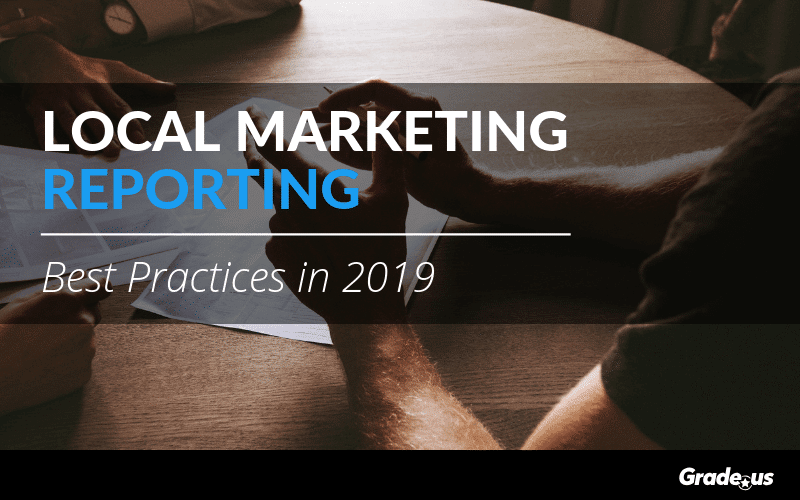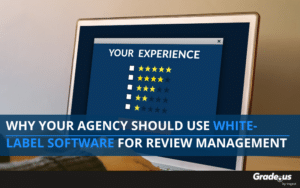Your agency needs a swear jar.
Well, not really a swear jar, it's more like a "marketing buzzword jar." Whit Hiler and his team at Cornett Agency feel many agencies need this to combat excessive jargon.
Here's how it works.
You and your employees put $1 in the jar whenever someone utters an overblown or overused piece of jargon. Drop the M-bomb (millennial) and you pay $2. It's funny, but it's actually a sign of a deeper, more troubling problem.
Do clients actually understand what we're saying?
It's one of the biggest mistakes agencies make when sharing their performance data with clients. Their local search campaigns have produced exceptional results. These agencies have generated leads, the phone is ringing, they're driving customers to their client's business.
So what's the problem?
Clients aren't getting the data they need in the format they need it. The performance data they receive is often vague and unclear. It's not because agencies aren't clear it's because clients are speaking a completely different language.
A different language?!
That's right. It's common for many agencies to treat their (small, medium and enterprise) clients the same which is actually a mistake.
Here's how.
- They share the same type of data with each and every client
- Typically they offer the same volume of data
- They use the same descriptors and jargon
- They assume each client representative has the same temperament
- Finally, they assume they have equal buy-in from each decision-maker/stakeholder (which they don’t)
So how does this affect agencies? They...
- Struggle to retain their clients
- Often lose the battle to justify their retainers, budgets or agreements
- Fight to keep/receive credit for their hard work
- Waste more time, money and resources preparing for, bidding on and winning new work
- Consistently lose the agency review process (which may not have anything to do with your reporting)
See what I mean?
No?
Here are some of the important takeaways I learned (sometimes the hard way) when working with clients.
- Small business clients are overwhelmed. They’re often forced to wear multiple hats. For small businesses, every dollar is precious. If you’re providing local marketing reporting, be concise, be actionable and show them the money. Ideally, your reporting shows they receive $2 for every $1 spent. Your work must primarily lead to one thing, revenue. Small businesses are dead in the water without it.
- Medium-sized clients are caught in limbo. They’re not small, they’re not big. Many medium-sized firms are still struggling with the issues that plagued them as a small business but now, they’re also dealing with the headaches and hassles that come with big business (e.g. compliance). They’re struggling to scale and they’re struggling to keep their momentum. Be sure your reporting shows them the money both now and in the future.
- Enterprise-class clients have internal and external concerns. Internally, they want to justify their budgets to their bosses. Decision-makers, influencers and point-of-contacts in an enterprise all have their own requirements and agendas. If you’re dealing with the CMO or other key executives, your report needs to (a.) make them look great in front of their boss (b.) provide clear, actionable data that justifies their spending (c.) Shows the measurable gains you’ve achieved for all essential metrics and KPIs.
So how do you report small, medium and large businesses?
You ask them.
You take the time to interview your clients during your intake process. You'll want to get a feel for a few important details:
1. The specific metrics and key performance indicators they want to see in your report
2. The specific format they prefer (e.g. PDF, web-based dashboard, email reports, mobile app, text messages, etc.)
3. The volume of data they require, per report
4. The descriptors and jargon they prefer (yes, some clients prefer jargon)
5. The frequency outlining how often they'd like to receive these reports (e.g. weekly or monthly - financially unstable clients = more reports, sophisticated clients = specific reports, disinterested clients = fewer reports, etc.)
You also want to assess the following details for your reporting process.
6. The overall temperament of each client representative involved (e.g. decision-makers, influencers, faux decision-makers, blockers and/or gatekeepers) in the account
7. The buy-in of each client representative (e.g. disinterested decision-makers, controlling influencers, power-hungry faux decision-makers, etc.)
Here's the bad news.
If you're managing these demands manually it's a recipe for disaster. It's doable in the beginning when you're first starting out. As your agency begins to grow this quickly becomes a huge and unmanageable time sink. As far as best practices go, this is a strong argument for web-based dashboards.
Here's the problem.
If you're like most agencies, you probably use multiple applications for local marketing. It's common for agencies to use tools like Moz, Grade.us, SEMRush, Authority Labs, Google analytics, and a variety of third-party tools for data. So you're stuck with PDFs then?
Not at all.
With tools like Cyfe, you're able to bring data from all of the apps you're already using into a single, all-in-one web-based dashboard. If you're an agency, you can white label their service. Prefer to build/integrate your own homegrown applications?
No problem, use their API.
Here's the best part about Cyfe. You can export your campaign data in the formats your clients prefer (e.g. PDF, CSV, PNG and JPG). You can also give clients their own set of credentials to access this dashboard.
What if you need more?
You can use Google Data Studio to build rich visualizations using existing data sources from a variety of marketing tools/sources. Julian from Measure School shows you how in his comprehensive course "Google Data Studio Dashboard Course".
Here's an official introduction from Google's own, Minhaz Kazi.
This is how you provide clients the data they need, in the formats they need, at scale.
Which metrics matter most to clients?
In my previous post, I shared a list of starter metrics you can use to show clients the money. Here are some simple questions you can ask your clients to identify the metrics and KPIs they'd like you to track. I've adapted this list from Dana Ditomaso's outstanding local marketing dashboard post at Moz.
1. Which conversion metrics/KPIs matter most to you? (e.g. purchases, leads, bookings, opt-ins)
2. Are visitors/customers converting? (conversions via calls, emails, forms, social media, etc.)
3. Where did these visitors/customers come from? (e.g. Yelp, Google Maps, Facebook Recommendations, etc.)
4. How much did clients spend (on average) to attract/acquire these customers?
5. How many (%) of these visitors/customers are coming from local marketing sources (e.g. Review Platforms, Google Maps, Waze, etc.)
6. Are clients visible in Google/Google Maps? (branded vs. unbranded)
7. How many qualified, traffic-producing keywords are clients currently ranking for?
8. What's the first [second, third, etc.] thing these visitors/customers do when they visit your site?
9. What conversion channel do most customers gravitate towards? Why? (e.g. messages, website visits, phone calls, text messages, social media, driving directions).
10. Where are visitors/customers getting stuck/experiencing friction?
These are simple questions you can ask clients during your intake process. They're simple, easy-to-understand and light on the jargon. These questions uncover what matters most to your clients.
The best practices we can draw from this
As an agency your job is difficult. You have to take the foreign and make it familiar. Make the difficult easy and the complex, simple. Here's a list of the best practices you can use to maximize your client's results.
1. Choose the metrics and KPIs that matter most to your clients
2. Set benchmarks. Use this as a reminder when clients forget where they were before you came along
3. Show clients the money. Place special emphasis on conversion, sales and ROI data
4. Make your data simple. Explain it simply, using clear visualizations and prompts
5. Verify that your client understands the data/dashboard and that things are easy-to-understand
6. Customize your client reports using metrics and KPIs, format, volume, descriptors and jargon, frequency, temperament and buy-in
7. Show year-over-year performance. For long term clients you'll want to show (a.) their campaign performance has improved month-over-month and (b.) it's improved year-over-year
8. Tell a story. Research shows we're captivated by stories. Use client data to tell a compelling story from the perspective of a customer or customer profile
9. Choose a reporting frequency that presents meaningful and valuable data. Don't give client's weekly reports if it takes months to see improvements. Explain the why behind your reporting schedule and defuse any objections that appear
10. Avoid irrelevant data. Don't show clients irrelevant data that fails to move the needle. Always tie things back to Items #1 and #2
11. Entice, never overwhelm with more. Always be ready to share more data in the event that clients have more questions on their campaign performance. Avoid sharing unasked for data/insights as this is more likely to create psychological indigestion
12. Analyze local's impact on other key marketing initiatives. Did local search produce a 17 percent lift with their display/rich media campaigns? Let clients know you're ready with that data (and insights) if they're interested
13. Review your reports with the client in-person, via a video or conference call. This reduces the likelihood that clients will draw inappropriate conclusions from the data. It also gives you a chance to show them the good, bad, and ugly results of the campaign (which builds trust)
14. Discuss your goals for the next reporting period. Show clients you're forward-looking and ready with a strategy to achieve bigger and better results. Project confidence showing them that you're excited to see where you can take them next
15. Maximize education, eliminate selling. Remember, education attracts client attention, information converts that attention to money. Always be teaching
Your clients will act on the data you share
Give them the understanding they need. Verify that they understand your reporting. Use these best practices to demonstrate that you've adapted the learning around them.
First and foremost be client focused.
This is one of the biggest mistakes agencies make when sharing their performance data with clients. Their local search campaigns produce outstanding results yet they're ousted as a result of poor reporting. It's an unnecessary failure that goes unnoticed.
Show clients the money.
Your clients are speaking a completely different language. You're an amazing professional. You're steeped in marketing and advertising. As a result, it's difficult to see that your clients aren't on your level.
This is why they need you.
Use this guide to speak their language. Give clients the data they need, in the format they need, when they need it. Don't treat your clients the same way, customize. Use software tools like Cyfe and Google Data Studio to provide clients with rich, customizable experiences.
Follow these reporting best practices and you'll find your agency is in the money.
About the Author
Andrew McDermott
Andrew McDermott is the co-founder of HooktoWin. He shows entrepreneurs how to attract and win new customers.








